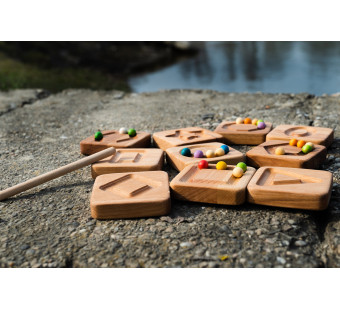 Montessori
Montessori
Montessori set of 10 dfiffferent geometric shapes
Reduced price!
-40%
€ 49,95
€ 29,97 tax incl.Omschrijving
A simple way to teach children about geometric elements and shapes, 10 pieces with geometric shapes, allowing for various tracing, recognition, matching, creative play, and sensory play activities.
From the earliest years of childhood, young children begin to form a conceptual idea of the shapes around them. As they learn about lines, they will move on to the next stage of understanding – geometric shapes. From the earliest years of childhood, young children begin to form a conceptual idea of the shapes around them.
The activities in this toy will help develop an understanding of lines and shapes.
Geometric shapes introduce the child to the second stage of early shape education. Children need many opportunities and exercises to learn about shapes, which surround them in everyday life. They learn to identify, distinguish and understand different shapes and the geometric objects of which these shapes are composed. This recognition is a very important basic concept in the evolution of the understanding of shape and form.
Every day, children are exposed to different forms of their environment. They not only see different shapes but also interact with them everywhere. That’s why it’s important to be able to recognize shapes, verbalize what they see, and understand why they are there.
As parents, we want, when our children see a shape, to make a connection. When looking at the wheel of a car, we want to process that image as a circle.
How to use the set:
- Trace the geometric shapes either with your finger or using the wooden tracing pencil. Then, when your child learns about circles, triangles, and squares, these exercises prepare them to recognize the lines and shapes of letters and numbers in the near future. And when your child learns to trace and draw geometric lines and shapes, this activity prepares them for writing and reading. All the exercises, which involve playing with lines and geometric shapes, help preschoolers develop writing and reading skills.
- Fill the geometric shapes with wooden balls or colored rice. Colored rice is an ideal complement when children learn colors, and also develop imagination and creativity. Colored rice is also used as a sensory element in various imaginative and creative games.
- Use the wooden spoon to fill the lines with rice, this activity will improve your child’s fine motor skills and concentration skills.
- Define a color for each shape. Match the shapes on the board with objects in the house that have identical shapes.
Why is it important for children to learn about geometric shapes?
- Recognizing geometric shapes is not only important in terms of developing spatial intelligence. The connections between mathematics and other fields (biology, chemistry, physics, robotics, astronomy, architecture, visual arts) are also made, laying an important foundation for future learning skills. Spatial intelligence or spatial thinking is that which allows us to locate and develop both ourselves and the objects around us, mentally and physically.
- Knowledge of shapes is vital for learning more complex geometry concepts.
- Learning about geometric shapes develops children’s visual memory, adding images and shapes to it.
- Young children’s ability to engage in geometric thinking and spatial reasoning supports their mathematical and cognitive development.
- Reading: a preschooler who is able to distinguish between shapes is better equipped to notice differences in letter shapes. This ability to observe will define the future learning time for reading and writing. Children practicing different shapes and lines will use these experiences when learning to read and write.
- Classification and comparisons: learning about the differences in geometric shapes requires a focus on the specific characteristics of each shape. In this way, preschoolers learn to use observational skills to identify different shapes. They also learn how to compare different shapes and group similar shapes. These observational skills transfer to other scientific fields. Observation and classification are key skills in science subjects.
- Problem-solving skills: educational activities with geometric shapes can help preschoolers develop problem-solving skills. An example is sorting toys with different geometric shapes. When a child recognizes the characteristics of a square, they can associate it with the square shape on the board. Recognizing geometric shapes also helps in solving puzzle games. If your child pays attention to the shapes of the pieces and the shapes of the openings in the puzzle, he will be able to determine the right place for all the pieces.
Learning colors and geometric shapes help children:
-
- understand mathematics and geometric concepts such as shape, size, space, and position more easily
- learn to sort and categorize; activities that are essential for problem-solving
- learn about letters and numbers because they are made up of lines and geometric shapes
- develop their vocabulary
- to develop their visual ability







